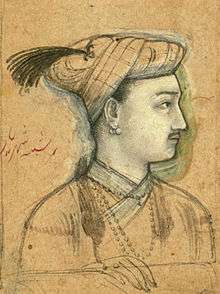Shahryar Mirza
Shahryar Mirza (16 January 1605 – 23 January 1628) was the fifth and youngest son of the Mughal emperor Jahangir. After Jahangir's death, Shahryar made an attempt to become emperor and was successful with the help of his powerful stepmother Nur Jahan, who was also his mother-in-law. However, he was only titular and suffered defeat and was killed at the orders of his victorious brother Shah Jahan. He was the paternal uncle of the last great Mughal Emperor Aurangzeb.
| Shahryar | |||||
|---|---|---|---|---|---|
 Shahryar | |||||
| Mughal Emperor (de facto) | |||||
| Reign | 7 November 1627 – 23 January 1628 | ||||
| Predecessor | Jahangir | ||||
| Successor | Shah Jahan | ||||
| Born | 16 January 1605 Agra | ||||
| Died | 23 January 1628 (aged 23) Lahore, Mughal Empire (present day Lahore, Pakistan) | ||||
| Burial | Lahore | ||||
| Spouse | Mihr-un-nissa Begum | ||||
| Issue | Arzani Begum | ||||
| |||||
| Dynasty | Timurid | ||||
| Father | Jahangir | ||||
| Mother | Bibi Fatehbadi | ||||
| Religion | Sunni Islam | ||||
|
||||||||||||||||||||||||||||||||||||||||||
Early years
Shahryar was born a few months before his grandfather, Emperor Akbar's death in 1605. His mother was a concubine.
In the 16th year of Jahangir's reign, Shahryar married Mihr-un-nissa Begum, the daughter of his step-mother Nur Jahan by her first marriage to Sher Afghan. Shahryar and Mihr-un-nissa had a daughter Arzani Begum.[1][2]
At Nur Jahan's request, he was given the pargana of Dholpur and its fort from Jahangir which Prince Khurram wanted for himself. He appointed Daria Khan, an Afghan, as its in-charge. This led to a skirmish between Nur Jahan's appointed in-charge Sharifu-l-Mulk, who was a servant of both Shahryar and Daria Khan. Sharifu-l-Mulk arrived on the scene shortly, and tried to force himself into the fort.[3]
On October 13, 1625, Jahangir appointed Shahryar as Governor of Thatta. Sharif-ul Mulk carried out the administration as the Deputy of the Prince.[4]
Ascension
After the death of his father Jahangir on 28 October 1627, Shahryar, as Nur Jahan desired, ascended to the Mughal throne, but for only three months. Since he was in Lahore at the time, he immediately took over the imperial treasury and distributed over 70 lakh rupees among old and new noblemen to secure his throne... Meanwhile, on the death of the Emperor, Mirza Baisinghar, son of the late Prince Daniyal, fled to Lahore and joined Shahryar.
Soon, near Lahore, Shahryar's forces met those of Asaf Khan, (father of Mumtaz Mahal), who wanted his son-in-law Shah Jahan to ascend the throne, and had already proclaimed Dawar as Emperor near Agra, as a stop-gap arrangement to save the throne for Shah Jahan. Shahryar lost the battle and fled into the fort, where the next morning he was presented in front of Dawar Baksh, who placed him in confinement and two to three days later had him blinded by Asaf Khan, thus bringing his short reign to a tragic end. It is said that Shahryar also had a form of leprosy due to which he had lost all his hair including his eyebrows and eyelashes.[5]
Like all Mughal princes, Shahryar also had training in poetry and, after he was blinded towards the end of his life, he wrote a poignant verse titled, Bi Gu Kur Shud didah-i-Aftab.[6]
Death
On the 2nd Jumada-l awwal, 1037 A.H., (1628), Shah Jahan ascended to the throne at Lahore, and on the 26th Jumada-l awwal, January 23 1628, upon his orders, Dawar, his brother Garshasp, Shahryar, and Tahmuras and Hoshang, sons of the deceased Prince Daniyal, were all put to death by Asaf Khan.[7][8]
Aftermath
After Shahryar's death, Shah Jahan ruled the empire for thirty years, until imprisoned by Aurangzeb and dying eight years later.
Asaf Khan, was made the prime minister of Mughal Empire, and Nur Jahan, with an annual pension of two lakh and spent the rest of her days, confined in her palace in Lahore, along with her daughter Mihr-un-nissa Begum, the widow of Shahryar.[9] Nur Jahan died in 1645 at age 68.[10]
Further reading
- Nur Jahan: Empress of Mughal India, by Ellison Banks Findly, Oxford University Press US. 2000. ISBN 0-19-507488-2.
References
- The Grandees of the Empire - Jahángír's children, Sultan Shahryar Ain-i-Akbari, by Abul Fazl, Volume I, Chpt. 30.
- Ali Q Ain-i-Akbari, by Abul Fazl, Volume I, chpt. 310, "'Alí Q.'s daughter, who, like her mother, had the name of Mihrunnisa, was later married to Prince Shahryar, Jahangir's fifth son.".
- Dholpur The Riyazu-s-Salatin (Gardens of the Sultans), a History of Bengal, by Ghulam Husain Salim ‘Zayadpuri’. 1787-8.
- Shahryar Governor The Calligraphers of Thatta By Muhammad Abdul Ghafur, 1968, Pakistan-Iran Cultural Association. Page 18.
- Proceedings of the Asiatic Society of Bengal, By Asiatic Society of Bengal, Asiatic Society (Calcutta, India). Published 1868. p. 218.
- Dictionary of Indo-Persian Literature, by Nabi Hadi, page 554.
- Death of the Emperor (Jahangir) The History of India, as Told by Its Own Historians. The Muhammadan Period, Sir H. M. Elliot, London, 1867–1877, Vol 6.
- Shahryar Nur Jahan: Empress of Mughal India, by Ellison Banks Findly, Oxford University Press US, page 275-282, 284, "23 January...".
- Noor Jahan University of Alberta.
- Shah Jahan britannica.com.